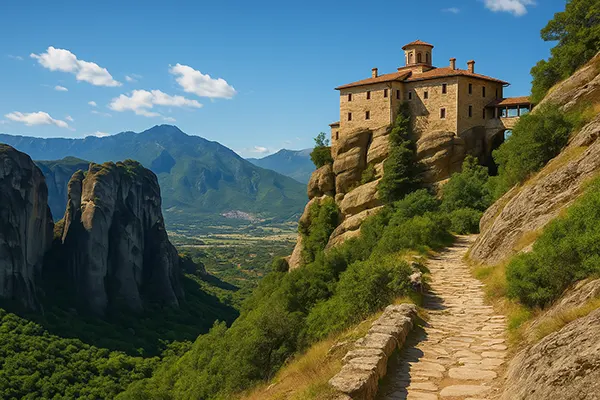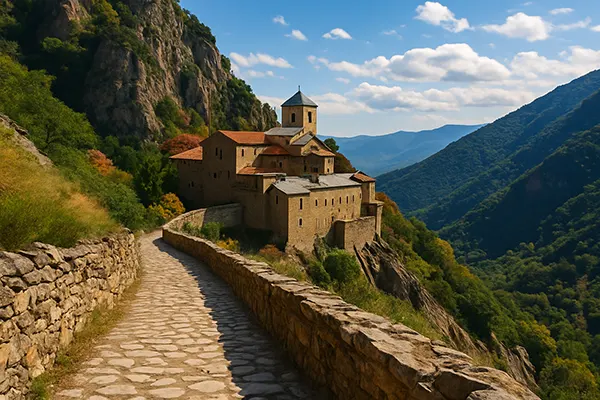
Rock Monasteries in Europe Still Reachable on Foot: A Guide to Remote Sanctuaries
Remote monastic sites across Europe preserve centuries of spiritual heritage and represent rare examples of early architectural mastery within untouched landscapes. Many of these sanctuaries remain accessible only by walking routes that follow historic pilgrimage paths, shepherd trails or natural mountain tracks. For modern travellers, they offer an opportunity to observe authentic religious communities, centuries-old frescoes and rugged natural settings shaped long before roads and modern infrastructure appeared.
Meteora Monasteries, Greece
The Meteora complex consists of centuries-old monasteries positioned on towering sandstone pillars that rise above the Thessaly Plain. Although several sites can be approached by road, the most historically accurate way to reach them remains the traditional footpaths carved into the slopes by early monks. These routes allow visitors to understand how the earliest inhabitants ascended the cliffs long before staircases and bridges existed.
Today, six monasteries remain active, each displaying wall paintings from the Byzantine and post-Byzantine period, preserved with strict conservation rules. The walking paths vary in difficulty, but the trail from Kastraki village to the Great Meteoron Monastery is considered the most representative route. It passes through forested areas and natural ledges that reflect the isolation sought by hermits during the 14th century.
As of 2025, Meteora continues to be protected as a UNESCO World Heritage Site, with regulations controlling foot traffic to preserve the rock formations and ancient steps. Walking access is permitted year-round, although summer temperatures may require more preparation. Most trails take between 30 minutes and 1.5 hours depending on the chosen monastery.
Walking Insights for Visiting Meteora
The most reliable starting points for traditional walking ascents remain the villages of Kastraki and Kalambaka. These local routes are maintained by regional authorities and marked with signage providing distance and elevation guidance. The advantage of ascending on foot is the chance to observe small hermit caves and abandoned monastic cells carved into the cliffside.
While the stone steps leading to the monastery entrances are modernised for safety, the majority of lower trails retain their natural form. Comfortable footwear and water supply are recommended, as shade is limited in certain sections. Access rules occasionally vary due to conservation work, and it is advisable to check the schedule of open monasteries in advance.
Photography is generally allowed on the exterior grounds, but interior spaces often follow strict policies to protect fragile artwork. Respect for ongoing religious practices is essential, as Meteora remains an active monastic community with functioning churches and daily services.
Sacra di San Michele, Italy
The Sacra di San Michele stands on Mount Pirchiriano in the Piedmont region and is among Italy’s most significant medieval sanctuaries. Its position at the top of a steep ridge makes it naturally defended and historically reachable only by foot. Although a minor road exists today, the authentic ascent remains the forest trail starting from the town of Sant’Ambrogio di Torino.
This walking route, known as the “Via dei Principi,” takes visitors along an ancient path used by pilgrims and soldiers during the Middle Ages. The climb spans approximately 600 metres in elevation and reveals several viewpoints overlooking the Susa Valley. Due to its high altitude, the sanctuary offers unobstructed views of the Alps during most months of the year.
The monastery structure includes Romanesque stonework, the “Stairway of the Dead,” 12th-century arches and fresco fragments preserved through long-term restoration programmes. As of 2025, Sacra di San Michele continues to serve as a symbol of Piedmont’s cultural identity and remains a key stop on long-distance walking routes that trace ancient pilgrim networks across northern Italy.
Walking Insights for Visiting Sacra di San Michele
The ascent typically takes 1.5 to 2.5 hours depending on pace and offers stable yet steep terrain. Waymarks guide visitors along the full route, with shaded sections that make the climb manageable even during warmer seasons. Winter access is possible but may require caution due to icy surfaces at higher elevations.
Upon reaching the entrance, visitors encounter the monumental “Porta dello Zodiaco,” a stone portal decorated with intricate sculptural work from the early 12th century. This feature is one of the reasons the monastery holds such architectural significance, as its carvings display remarkable preservation despite centuries of exposure.
The sanctuary grounds include terraces, chapels and defensive structures that illustrate its strategic importance. Although the monastery no longer houses a large monastic community, caretakers supervise archaeological research and oversee conservation efforts. The location’s isolation continues to contribute to its authenticity, making the walk a meaningful part of the experience.

Rila Monastery Hermitage Trails, Bulgaria
While the main Rila Monastery is accessible by road, several surrounding hermit dwellings remain reachable only on foot. These sites, linked to the legacy of St Ivan of Rila, are located deep within the Rila Mountains and remain some of the most secluded monastic refuges in southeastern Europe. They offer visitors a glimpse into the earliest forms of monastic life, shaped by solitude and the natural environment.
The most notable walking route leads to the cave where St Ivan of Rila lived during the 10th century. This path begins near the monastery complex and climbs through dense forests, following well-maintained steps and traditional mountain tracks. The hermitage consists of a chapel, a stone altar and a narrow rock passage symbolically associated with spiritual cleansing.
Additional walking paths lead to remote chapels and monastic shelters used by monks for meditation and seasonal retreats. As of 2025, these trails continue to be supervised by the Bulgarian Orthodox Church in cooperation with national park authorities to ensure visitor safety and environmental protection.
Walking Insights for the Rila Hermitages
The hermitage paths typically require between 30 minutes and 1 hour of walking and involve moderate elevation gain. Surfaces may become slippery during spring and autumn due to rainfall, so sturdy footwear is recommended. The routes are clearly marked, and rest areas are available along the forested sections.
Although the main monastery attracts large numbers of visitors, the hermitage trails remain noticeably quieter. This makes them suitable for travellers wishing to observe natural mountain surroundings combined with early monastic architecture. The combination of woodland scenery and historical significance gives the walk a distinct atmosphere.
Inside the hermit chapels, photography is often restricted to protect religious items and fragile frescoes. Visitors are encouraged to approach the sites with respect, as they remain active places of prayer for monks and pilgrims throughout the year.
